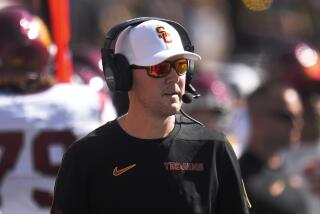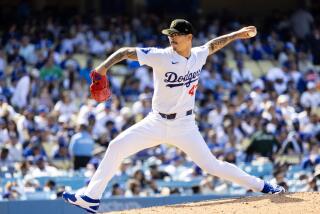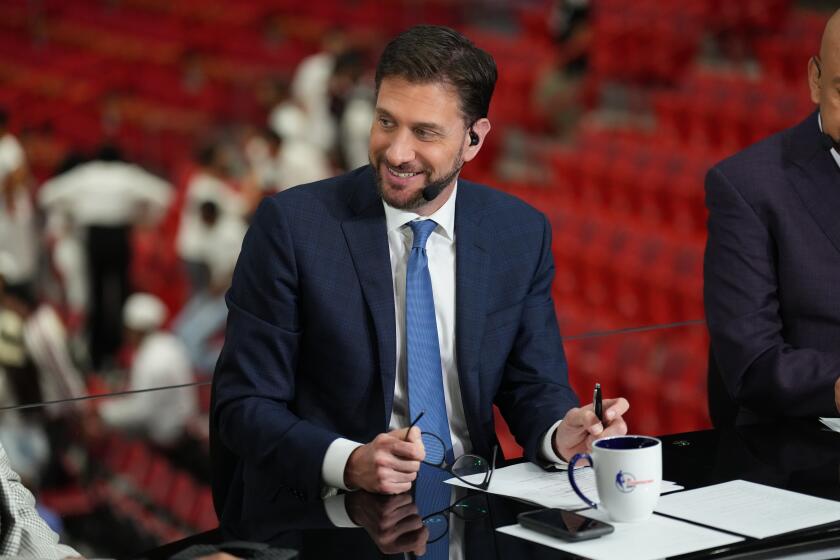The Franchise
Every spring, the swallows return to Capistrano, Salmon returns to Anaheim and the race cars return to Long Beach. No need to mark it on your calendar. If you live in Long Beach, all you need to know that spring is in the air are your five senses.
Smell the exhaust fumes, commingling with the aroma of suntan lotion and grilled animal flesh.
Hear the engines buzzing in the distance, like killer bees at a mating festival.
Taste the beer that flows from spigots like wine at a Bacchanalian chariot race.
Touch the celebrities playing hooky from Hollywood on a long lost weekend.
See the tow truck make a move on your car that suddenly has been deemed “illegally parked.”
If it’s April in Long Beach, it must be the Toyota Grand Prix, where temporary bleachers hug Shoreline Drive with a symbolism not lost on anyone familiar with this city’s sporting history, consisting largely of fans temporarily embracing a team or an event before they eventual high-tail it out of town.
Follow the bouncing baseball team that began life as the Barracuda, then the Riptide, winning two Western Baseball League championships in two years in Long Beach before moving to Mission Viejo and then to St. George, Utah.
Remember the StingRays? Many locals still do, since it wasn’t that long ago that the team debuted as a charter member of the women’s American Basketball League, ill-fated rival to the WNBA. The StingRays were an instant on-the-court success, reaching the final playoff series in the ABL’s first season, and then, just as suddenly, extinct--folding days before the ABL’s second and final season.
Long Beach State once had a football program that stocked the NFL with such names as Terry Metcalf, Billy Parks, Dan Bunz, Mark Seay, Leon Burns--and borrowed one, a pretty big one, when the school lured George Allen out of retirement to coach the 49ers in 1990. Terrell Davis even played there, for one season, before the university voted to scrap football in 1991. Davis transferred to Georgia.
Once, the Rams practiced at Blair Field. Once, the Big West Conference held its postseason basketball tournament at the Long Beach Arena, now adorned by the world’s largest and ugliest sea-life mural, confusing hundreds of tourists who regularly pull into the wrong parking lot, mistaking the arena and its spray-painted whales for the nearby Aquarium of the Pacific.
Inside the pseudo fish tank, on a rink of frozen water, the minor league Ice Dogs still toil, although for how much longer is uncertain. The Ice Dogs’ Long Beach Arena lease runs through 2002, but the team usually plays before crowds of fewer than 4,000 and perpetually operates at a loss. Meanwhile up the freeway, the Forum, which used to have a full-time hockey tenant, is scouting for a replacement.
On any given Sunday in Long Beach, you can see sailboaters bobbing in the marina, kayakers paddling through the Naples canals, roller-bladers swatting plastic pucks at Bayshore Park, soccer players shanking free kicks at Heartwell Park. But when it comes to the spectator-sports experience, there is no long haul in Long Beach.
Or, as it is known among sports promoters who previously have tried and failed, Not For Long Beach.
Which makes the Grand Prix, now readying for its 27th year of torturing ear drums, the oddest of Long Beach anomalies. It came and it stayed. It survives and it thrives. It is a civic touchstone, operating not far from where the Spruce Goose once nested before it too, was airlifted far away. And, recently having signed a contractual extension with the city through 2010, it doesn’t appear to be going anywhere else soon.
“I think the Grand Prix has been spectacular for Long Beach,” says Don Dyer, Long Beach State senior assistant athletic director and a Long Beach resident for more than 40 years. “I can’t imagine anything having any more effect, including the Queen Mary. The Grand Prix has been better for Long Beach than any other single event since I’ve been here.”
Says David Simon, president of the Los Angeles Sports Council, “When you think back to the early years of the race and where it is now, it’s pretty unbelievable. It’s one of the two or three events of its kind in North America. From a sports standpoint, it put Long Beach on the map. Clearly, it’s the biggest attraction the city has had.”
Those early years were the sort that have sunk more than one franchise in Long Beach. Considerable local skepticism at the outset. Serious shortages of cash. Format changes. Course changes. Flirtations from other cities on the prowl to poach.
Yet, in a professional sports market that often looks down its nose at Long Beach, dismissing it as a poor man’s Anaheim or a beach-side Des Moines, the Grand Prix has outlasted five area professional football teams--the Anaheim-incarnation Rams, the L.A.-era Raiders, the USFL Express, the indoor Cobras and Piranha--with a sixth, the XFL’s Xtreme, idling on the off-ramp.
It has been a Southern California fixture longer than the Clippers, longer than the L.A. Marathon, longer than the life spans of the Galaxy, the Mighty Ducks, the Sparks and the Avengers combined.
“I don’t have to tell you how tough it is in Southern California to maintain a sports team,” says Chris Pook, founder of the Long Beach Grand Prix and president of the Grand Prix Assn. of Long Beach. “If you’re the Dodgers or the Angels or the Lakers or the Clippers or the Kings--or, I guess, the Ducks--it’s OK. But once you get out of the top tier of sports, it gets difficult. I mean, Major League Soccer, in all the markets where they thought they’d be a huge success, I think they’re doing OK.
“So it’s tough in Southern California if you’re not in the top league. That’s why Long Beach has had several minor league teams [that have struggled].”
Pook believes the Grand Prix has lasted because it’s “a unique product in Southern California that started in ‘75, and I think over the years we have built a relationship with the city. That’s really important. And we built a relationship with our fans. I think the bottom line is, as a result of those relationships, we’ve been able to be reasonably successful.”
*
Little-known fact about Long Beach:
The city almost had the Angels.
When Gene Autry was looking to move his team out of Los Angeles and into the suburbs in the early 1960s, his first option was Long Beach.
Autry liked the location, midway between Los Angeles and Orange County, with easy freeway access. The plan was to build a stadium on property that is now El Dorado Regional Park. Negotiations between the Angels and the city progressed until hitting what appeared to be a minor snag: What to call the team.
The city demanded the team be called the Long Beach Angels.
Autry, thinking the name sounded too minor league, insisted on the Los Angeles Angels or the California Angels.
The city held out for Long Beach . . . and that was the deal breaker.
Anaheim, which later would have no trouble selling its soul--and any chance for an NBA future--to bring in Disney’s Ducks, was more flexible. You want the California Angels, Mr. Autry, you’ve got ‘em. Come on down.
Just like that, the course of major league baseball history was forever altered. There are no ancient Indian burial grounds beneath El Dorado Park, to the best of anyone’s knowledge. Had the Angels moved to Long Beach instead of Anaheim, who knows? Donnie Moore might have struck out Dave Henderson. Mark Langston might have won the playoff against Seattle. Gene Mauch might have swept the Brewers in ’82. Pennants might be flying over the heads of Long Beach baseball fans today.
“That sounds like something Long Beach would have done,” says Dyer, laughing at the city’s fateful fit of stubbornness.
A decade later, Pook went to the Long Beach city fathers with an idea much more outlandish: Let’s say we run a Formula One street race through downtown Long Beach, just like they do in Monte Carlo!
The city’s initial reaction: Who let this crazy Brit out of his padded cell?
“It was a hard way to go,” Pook says. “No one had ever done modern-day street racing on the scale that we were doing it.”
And in Long Beach, no less. In 1975, the downtown area was notoriously seedy, resembling the morning after an all-night drunken sailors’ brawl.
“Must we go there?” Pook says when asked for a description of downtown Long Beach then.
“It was pretty bad. There were a lot of people sleeping in doorways. A lot of interesting ladies would say good evening to you. . . . It was in pretty good decay.”
The city had a serious need for redevelopment and Pook, a travel agent working in Long Beach, was interested in exploring new ways to bring business, and tourists, to the city.
“Long Beach made a decision in the early ‘70s, when its oil revenues were depleting, to become a convention and tourist destination,” he says. “The problem was that apart from the Queen Mary, it had no real hotels and no one really knew where Long Beach was. If you’re going to become a convention and tourist destination, you have to have an identity. You have to have hotels for people to stay in.
“I basically said, ‘This is going to take 10 or 12 years to get this thing going, to get those hotels built. It’s going to take a huge amount of money, if we slug it out the normal method. If we really want to get attention and be aggressive about redevelopment and really make this place into a destination, then let’s do something outrageous. Like running race cars on the streets.
“There was nothing novel about that. Monte Carlo had been doing it and using that as a marketing technique for years. So what we really did was copy Monte Carlo.”
From a public relations standpoint, “Monte Carlo West” was an upgrade over “Iowa By The Sea,” any way you looked at it.
So Pook and Long Beach took the plunge in 1975 with a trial-run Formula 5000 race. It sold, and the next year Pook brought in the elite Formula One cars and crowd for a weekend of speed and expensive parties. It all went over very big--and nearly collapsed under its own weight.
The Grand Prix nearly went bankrupt in 1977.
“A very tough time,” Pook remembers. “We had a hard time with cash flow that year, but we were determined to see it through. We believed in our business plan, we believed in our concept. We said, ‘If we can just get through this 1977 event, we could see profitability on the horizon.’ ”
That year, the race was won by Mario Andretti, the first American to win a Formula One race in this country. And, with Andretti’s victory, a race was saved.
“When Mario won in ‘77, that plastered our event all across the nation,” Pook says. “Andretti’s a pretty magic name, and he won it in a storied car with a storied owner, Colin Chapman’s Lotus. So, it had all the right bits and pieces. The story moved off the sports pages to the front pages. And that was critical. It was almost our stamp of approval.”
Not long afterward, Pook says, he received offers from San Diego and other cities to uproot the race from Long Beach. Pook and his staff resisted the overtures because, he says, “We’re basically Long Beach people. The city made a commitment to go with us and they were the ones that took the risk in the first place. And trusted us to get the job done. So when other cities just kind of said, ‘Why don’t you think about coming here?’ we declined.”
There were other bumps along the way. In 1984, in a move to cut overhead, Pook switched from Formula One cars, which had to be brought at extravagant cost from Europe, to Indy cars from the American CART circuit. Attendance dipped from 182,000 in 1983 to 135,000 in ‘84, when Andretti rescued the race again with another attention-grabbing victory.
As the race persevered, Long Beach grew with it. Today, the backdrop of the Grand Prix course includes the aquarium and rows of trendy restaurants and bistros--a postcard advertisement for Long Beach now seen throughout the world via international television.
Simon, who along with Pook has organized a bid to bring the 2005 world aquatics championships to Long Beach, uses the Grand Prix as a calling card when meeting with officials from Europe and Asia.
“When you say ‘Long Beach Grand Prix,’ that’s an expression that is instantly understood around the world,” Simon says. “It resonates with people in Europe who don’t know otherwise where, or what, Long Beach is.”
The race also has broken the long-held Long Beach stereotype that it can’t happen here.
Dyer believes the Grand Prix has stuck, whereas the Riptide and StingRays have washed out to sea, because, “It’s not just a sporting event. It’s an event that everybody in the city can take part in, whether they know anything about car racing or not. I mean, it’s a party, it’s a happening. It’s a colorful huge circus, besides a car race.”
And, just like a circus, it rolls into town for a few days, then picks up and moves on. It’s hard to overstay your welcome doing that. It’s three days of fumes, fuss and fun. Then Long Beach goes back to windsurfing and tennis and soccer, enjoying its sporting life, so long as it’s done outdoors and without cheerleaders.
More to Read
Go beyond the scoreboard
Get the latest on L.A.'s teams in the daily Sports Report newsletter.
You may occasionally receive promotional content from the Los Angeles Times.










